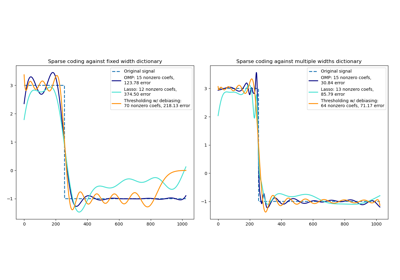sklearn.decomposition.SparseCoder¶
- class sklearn.decomposition.SparseCoder(dictionary, *, transform_algorithm='omp', transform_n_nonzero_coefs=None, transform_alpha=None, split_sign=False, n_jobs=None, positive_code=False, transform_max_iter=1000)[source]¶
Sparse coding.
Finds a sparse representation of data against a fixed, precomputed dictionary.
Each row of the result is the solution to a sparse coding problem. The goal is to find a sparse array
codesuch that:X ~= code * dictionary
Read more in the User Guide.
- Parameters:
- dictionaryndarray of shape (n_components, n_features)
The dictionary atoms used for sparse coding. Lines are assumed to be normalized to unit norm.
- transform_algorithm{‘lasso_lars’, ‘lasso_cd’, ‘lars’, ‘omp’, ‘threshold’}, default=’omp’
Algorithm used to transform the data:
'lars': uses the least angle regression method (linear_model.lars_path);'lasso_lars': uses Lars to compute the Lasso solution;'lasso_cd': uses the coordinate descent method to compute the Lasso solution (linear_model.Lasso).'lasso_lars'will be faster if the estimated components are sparse;'omp': uses orthogonal matching pursuit to estimate the sparse solution;'threshold': squashes to zero all coefficients less than alpha from the projectiondictionary * X'.
- transform_n_nonzero_coefsint, default=None
Number of nonzero coefficients to target in each column of the solution. This is only used by
algorithm='lars'andalgorithm='omp'and is overridden byalphain theompcase. IfNone, thentransform_n_nonzero_coefs=int(n_features / 10).- transform_alphafloat, default=None
If
algorithm='lasso_lars'oralgorithm='lasso_cd',alphais the penalty applied to the L1 norm. Ifalgorithm='threshold',alphais the absolute value of the threshold below which coefficients will be squashed to zero. Ifalgorithm='omp',alphais the tolerance parameter: the value of the reconstruction error targeted. In this case, it overridesn_nonzero_coefs. IfNone, default to 1.- split_signbool, default=False
Whether to split the sparse feature vector into the concatenation of its negative part and its positive part. This can improve the performance of downstream classifiers.
- n_jobsint, default=None
Number of parallel jobs to run.
Nonemeans 1 unless in ajoblib.parallel_backendcontext.-1means using all processors. See Glossary for more details.- positive_codebool, default=False
Whether to enforce positivity when finding the code.
New in version 0.20.
- transform_max_iterint, default=1000
Maximum number of iterations to perform if
algorithm='lasso_cd'orlasso_lars.New in version 0.22.
- Attributes:
n_components_intNumber of atoms.
n_features_in_intNumber of features seen during
fit.- feature_names_in_ndarray of shape (
n_features_in_,) Names of features seen during fit. Defined only when
Xhas feature names that are all strings.New in version 1.0.
See also
DictionaryLearningFind a dictionary that sparsely encodes data.
MiniBatchDictionaryLearningA faster, less accurate, version of the dictionary learning algorithm.
MiniBatchSparsePCAMini-batch Sparse Principal Components Analysis.
SparsePCASparse Principal Components Analysis.
sparse_encodeSparse coding where each row of the result is the solution to a sparse coding problem.
Examples
>>> import numpy as np >>> from sklearn.decomposition import SparseCoder >>> X = np.array([[-1, -1, -1], [0, 0, 3]]) >>> dictionary = np.array( ... [[0, 1, 0], ... [-1, -1, 2], ... [1, 1, 1], ... [0, 1, 1], ... [0, 2, 1]], ... dtype=np.float64 ... ) >>> coder = SparseCoder( ... dictionary=dictionary, transform_algorithm='lasso_lars', ... transform_alpha=1e-10, ... ) >>> coder.transform(X) array([[ 0., 0., -1., 0., 0.], [ 0., 1., 1., 0., 0.]])
Methods
fit(X[, y])Do nothing and return the estimator unchanged.
fit_transform(X[, y])Fit to data, then transform it.
get_feature_names_out([input_features])Get output feature names for transformation.
get_params([deep])Get parameters for this estimator.
set_output(*[, transform])Set output container.
set_params(**params)Set the parameters of this estimator.
transform(X[, y])Encode the data as a sparse combination of the dictionary atoms.
- fit(X, y=None)[source]¶
Do nothing and return the estimator unchanged.
This method is just there to implement the usual API and hence work in pipelines.
- Parameters:
- XIgnored
Not used, present for API consistency by convention.
- yIgnored
Not used, present for API consistency by convention.
- Returns:
- selfobject
Returns the instance itself.
- fit_transform(X, y=None, **fit_params)[source]¶
Fit to data, then transform it.
Fits transformer to
Xandywith optional parametersfit_paramsand returns a transformed version ofX.- Parameters:
- Xarray-like of shape (n_samples, n_features)
Input samples.
- yarray-like of shape (n_samples,) or (n_samples, n_outputs), default=None
Target values (None for unsupervised transformations).
- **fit_paramsdict
Additional fit parameters.
- Returns:
- X_newndarray array of shape (n_samples, n_features_new)
Transformed array.
- get_feature_names_out(input_features=None)[source]¶
Get output feature names for transformation.
The feature names out will prefixed by the lowercased class name. For example, if the transformer outputs 3 features, then the feature names out are:
["class_name0", "class_name1", "class_name2"].- Parameters:
- input_featuresarray-like of str or None, default=None
Only used to validate feature names with the names seen in
fit.
- Returns:
- feature_names_outndarray of str objects
Transformed feature names.
- get_params(deep=True)[source]¶
Get parameters for this estimator.
- Parameters:
- deepbool, default=True
If True, will return the parameters for this estimator and contained subobjects that are estimators.
- Returns:
- paramsdict
Parameter names mapped to their values.
- property n_components_¶
Number of atoms.
- property n_features_in_¶
Number of features seen during
fit.
- set_output(*, transform=None)[source]¶
Set output container.
See Introducing the set_output API for an example on how to use the API.
- Parameters:
- transform{“default”, “pandas”}, default=None
Configure output of
transformandfit_transform."default": Default output format of a transformer"pandas": DataFrame outputNone: Transform configuration is unchanged
- Returns:
- selfestimator instance
Estimator instance.
- set_params(**params)[source]¶
Set the parameters of this estimator.
The method works on simple estimators as well as on nested objects (such as
Pipeline). The latter have parameters of the form<component>__<parameter>so that it’s possible to update each component of a nested object.- Parameters:
- **paramsdict
Estimator parameters.
- Returns:
- selfestimator instance
Estimator instance.
- transform(X, y=None)[source]¶
Encode the data as a sparse combination of the dictionary atoms.
Coding method is determined by the object parameter
transform_algorithm.- Parameters:
- Xndarray of shape (n_samples, n_features)
Training vector, where
n_samplesis the number of samples andn_featuresis the number of features.- yIgnored
Not used, present for API consistency by convention.
- Returns:
- X_newndarray of shape (n_samples, n_components)
Transformed data.
